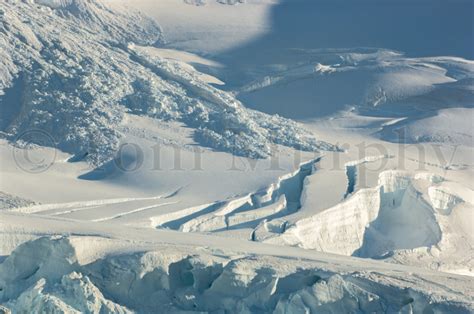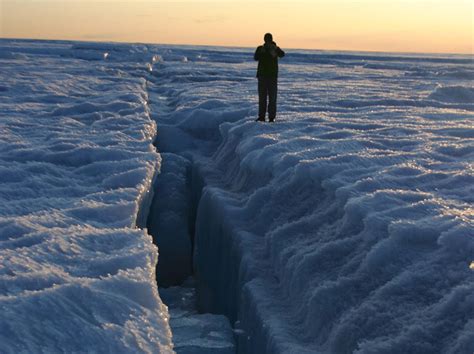Crevasses In Antarctica

Antarctica, the southernmost continent on Earth, is a land of extreme conditions and unique geological phenomena. Among the many captivating features of this frozen wilderness, crevasses stand out as an iconic and significant aspect of the Antarctic landscape. These deep cracks in the ice, often hidden beneath a thin layer of snow, present a constant challenge and a subject of great interest to scientists and adventurers alike.
The Formation and Characteristics of Antarctic Crevasses

Crevasses are a result of the complex interplay between the movement of glaciers, the flow of ice sheets, and the varying temperatures and pressures experienced in Antarctica. As glaciers and ice sheets move across the continent, they encounter obstacles such as rock outcrops or changes in the underlying topography. This movement causes the ice to stretch and fracture, leading to the formation of crevasses.
Antarctic crevasses can vary greatly in size and depth. Some may be mere inches wide and shallow, easily overlooked by the untrained eye, while others can be several meters wide and extend down hundreds of meters into the ice. These massive crevasses often form distinct patterns, with networks of cracks branching out in intricate designs across the ice.
The depth of a crevasse is a critical factor, as it can pose significant hazards to both humans and animals. A single misstep can result in a fall into a hidden crevasse, with potentially fatal consequences. For this reason, navigation across crevasse-filled areas requires specialized equipment and training, with researchers and explorers relying on tools such as ice radar and crevasse detectors to ensure their safety.
The Role of Temperature and Pressure
Temperature and pressure play a crucial role in the formation and behavior of Antarctic crevasses. In regions where the ice is subjected to high pressures, such as near the coast or beneath the weight of an ice shelf, the ice tends to deform and flow more readily. This can lead to the formation of large crevasses, often extending down to the bedrock below.
Conversely, in areas with lower pressures and more stable temperatures, the ice is more likely to fracture into smaller, shallower crevasses. Understanding these patterns is vital for scientists studying the dynamics of the Antarctic ice sheet and its response to climate change.
| Crevasse Type | Characteristics |
|---|---|
| Pressure Ridges | Formed by the compression of ice, often at the edge of ice shelves, resulting in tall, jagged ridges of ice. |
| Longitudinal Crevasses | Extend parallel to the flow of the glacier, often forming in areas of high ice velocity. |
| Transverse Crevasses | Cut across the flow of the glacier, typically forming in areas of shearing or where the ice encounters an obstacle. |

The Impact of Crevasses on Antarctic Ecosystems

While crevasses present a significant challenge to human exploration and research in Antarctica, they also play a crucial role in shaping the continent’s unique ecosystems. The presence of crevasses can influence the distribution of wildlife and the overall biodiversity of the region.
Crevasses as Habitat
Surprisingly, crevasses provide habitat for a variety of Antarctic organisms. Some crevasses, particularly those that are partially filled with water, support a diverse range of microbial life. These microscopic organisms, including bacteria and algae, can survive in the extreme conditions within the crevasses, contributing to the overall ecosystem.
In addition, certain animals, such as the Antarctic midge, have evolved to utilize crevasses as part of their life cycle. These tiny insects lay their eggs in the moist environments found within crevasses, providing a unique breeding ground that is protected from the harsh winds and extreme temperatures of the open ice.
Influence on Wildlife Distribution
The presence of crevasses can also influence the distribution of larger wildlife in Antarctica. For instance, certain bird species may choose to nest on the edges of crevasse fields, taking advantage of the protection offered by the deep cracks in the ice. This can lead to concentrated populations of birds in specific areas, creating unique ecological niches.
Furthermore, the formation of crevasses can create microclimates, with slightly warmer temperatures and more stable conditions compared to the surrounding open ice. These microclimates can support a richer array of plant and animal life, contributing to the overall biodiversity of the region.
Exploring Crevasse Fields: Safety and Scientific Research
The exploration of crevasse fields in Antarctica is a delicate and dangerous undertaking. Researchers and explorers must navigate through these complex landscapes with caution, employing a range of specialized equipment and techniques to ensure their safety.
Safety Measures
Before venturing into a crevasse field, teams typically conduct thorough surveys using ice radar and other tools to map the layout of the crevasses. This helps to identify potential hazards and plan safe routes. Additionally, explorers often use crevasse detectors, which can alert them to the presence of hidden cracks in the ice.
Proper equipment is essential for navigating crevasse fields. This includes specialized crampons and ice picks designed for traversing icy terrain, as well as safety ropes and harnesses to prevent falls. In some cases, researchers may even use drones or other remote sensing technologies to gain a bird's-eye view of the crevasse field before entering it on foot.
Scientific Research in Crevasse Fields
Crevasse fields offer a unique opportunity for scientific research. By studying the formation and behavior of crevasses, scientists can gain insights into the dynamics of ice flow and the response of the Antarctic ice sheet to climate change. This research is crucial for understanding the potential impacts of global warming on the continent’s ice and its contribution to sea level rise.
Researchers also investigate the ecological role of crevasses, studying the microbial life and animal species that inhabit these environments. This work contributes to our understanding of Antarctic biodiversity and the resilience of these unique ecosystems in the face of a changing climate.
The Future of Antarctic Crevasses: Climate Change and Impacts
As the climate continues to warm, the dynamics of Antarctic crevasses are likely to change. Rising temperatures can affect the formation and behavior of crevasses, potentially leading to increased instability and the formation of more extensive crevasse fields.
Crevasse Formation and Climate Change
Warming temperatures can cause the ice to melt and refreeze, creating conditions that are more conducive to the formation of crevasses. This process can lead to the development of new crevasse fields and the expansion of existing ones. As a result, the risk of crevasse-related accidents may increase, posing challenges for both human safety and wildlife habitats.
Implications for Ice Sheet Stability
The stability of the Antarctic ice sheet is closely linked to the behavior of crevasses. As crevasses form and expand, they can weaken the ice sheet, potentially leading to accelerated ice loss and an increased contribution to sea level rise. Understanding these processes is crucial for predicting the future behavior of the ice sheet and its potential impacts on global sea levels.
In conclusion, Antarctic crevasses are a captivating and significant feature of the continent's landscape, offering both challenges and opportunities for scientific research. As we continue to explore and study these unique environments, we gain valuable insights into the dynamics of the Antarctic ice sheet and its response to a changing climate.
¿Cómo se forman las grietas en la Antártida?
+Las grietas se forman debido al movimiento de los glaciares y la dinámica de las capas de hielo. Cuando el hielo fluye y se deforma, se producen tensiones y fracturas que dan lugar a las grietas.
¿Qué peligro representan las grietas para los exploradores y la vida silvestre?
+Las grietas pueden ser peligrosas para los exploradores, ya que un paso en falso puede resultar en una caída. Para la vida silvestre, las grietas pueden alterar su hábitat y distribución, afectando la biodiversidad de la región.
¿Cómo afecta el cambio climático a las grietas antárticas?
+El cambio climático puede influir en la formación y comportamiento de las grietas. Las temperaturas más cálidas pueden conducir a la fusión y refusión del hielo, creando condiciones que favorecen la formación de grietas. Esto podría tener implicaciones para la estabilidad de la capa de hielo antártica y su contribución a la subida del nivel del mar.



